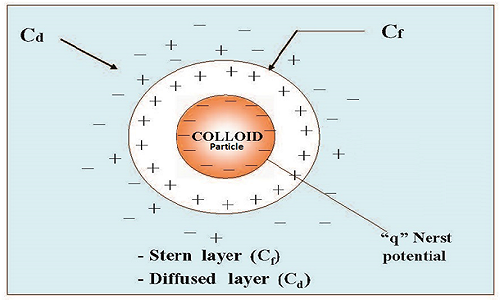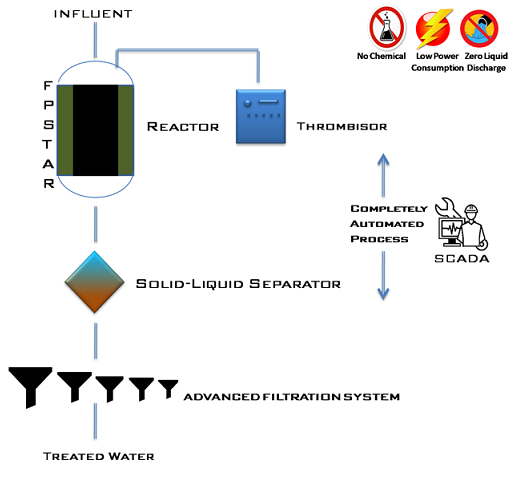AQUATRON

FPSTAR TECHNOLOGY
FPSTAR stands for Fine Particle Shortwave Thrombotic Agglomeration Reactor. It is a disruptive innovation technology in the water treatment sector. It is inspired by nature, a universal solution for waste, yet customizable to your needs. The process mimics blood clotting in the human body. The unwanted particles are engineered to collide and agglomerate in the reactor and then removed by multi-stage filtration defined by end-use requirement.
A single particle in water
Particles finer than 0.1 μm (10-7m) in the water remain continuously in motion due to electrostatic charge (often negative) which causes them to repel each other. Once their electrostatic charge is striped (neutralized) by the use of a special technique that forms met complex ionization, shortwave bombardment, and simultaneously causing flow turbulence, the finer particles start to collide and agglomerate (combine together) under the influence of Vander Waals’s forces. These larger and heavier particles are called Thrombus (clots) and the process is called Fine Particle Thrombousthai Reaction and is done in a Fine Particle Thrombousthai Reactor or FPTR.

Mechanism of Action
In a typical FPTR reactor, a similar mechanism is mimicked; first, the fine particles in liquids behave in the same way as the fibrinogen in the blood, with a sticky portion at the center and a negative charge as shown in the figure above. The charge here is clipped off by applying high-intensity shortwaves through a specialized system of surfaces called Curdiliser. The Inner vessel of the reactor is known as the Reactor Core consists of the Curdiliser, which are cylindrical structures made up of complex alloys consisting of Aluminum, Magnesium, Zinc, Copper, Manganese, Titanium, and sometimes even Platinum, Iridium, silver, and Gold, depending on the particle composition and the wastewater to be treated. The liquid to be treated will be pulse fed to the Reactor Core, with a suitable pulsating pump. Flow turbulence is caused by a second pump called the Turbuliser. When appropriate high energy combined with a short wave of different frequencies is delivered to these structures, to form soluble monomeric and polymeric hydroxo- complexes. These Metcomplexes formed depends on the type of alloy, which is chosen for a particular characteristic of the particles that need to be clotted. These Metcomplexes are the ones that stick together, beginning the formation of clots, as the fibrins in the blood. The figure below gives an idea of the mechanism. The Interesting part of this process is, it can also clot materials that do not otherwise form precipitate (cause (a substance) to be deposited in solid form from a solution by physical or chemical reactions) such as sodium and potassium and non-flocculating (not able to form into an aggregated lumpy or fluffy mass by use of chemicals ) or non-coagulating materials like benzene, toluene or similar complex organic compounds can also be thrombolated (a process of achieving extremely fine particle agglomeration by application of high energy shortwave ) and removed. Tough to remove substances like lignin, a macromolecule composed of three monomers namely p-coumaryl alcohol, coniferyl alcohol, and sinapyl alcohol, or its derivatives can also be thrombolated and removed by the FPTR Process by retreating it with extra high tension millimeter-wave bombardment.

FPSTAR Process Benefits
Reduce COD and BOD by 95% +
Agglomerate particles as small as 0.01 μm in water to 10 μm to 1.5 mm and filtered through conventional aids.
Extremely fast reaction time processes water online and clean water available for recycling immediately.
Arsenic, Nitrates, Heavy Metals, and Fluoride reduction
Softening Solids as fast sedimentation Aid
Very small space requirements.
Very effective in the removal of high and low turbidity
Extremely effective in the removal of Color, TOC, NOM, and DBP precursors
Works over a wide pH range
Low cost compared to conventional methods of water treatment and recovery.
Makes heavier particles that settle faster and works better in cold water
Produces higher sludge concentrations resulting in Lower sludge disposal costs

